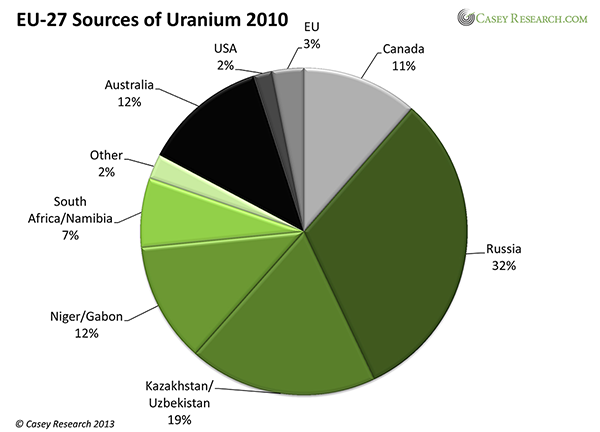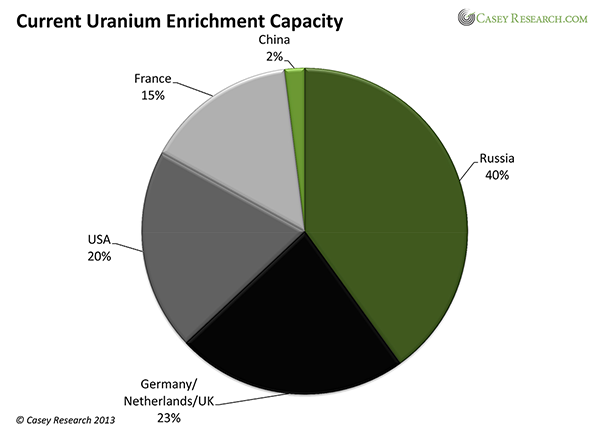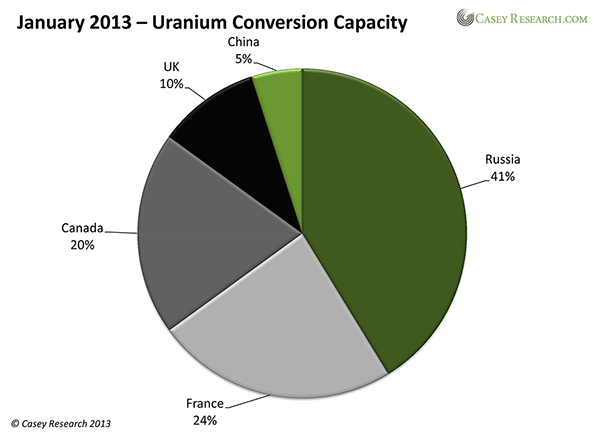Although we don’t like to admit it, Uranium is a big part of the energy picture with roughly 16% of the world’s electricity coming from nuclear power. In the U.S. it is almost the same at 19%, with 37% coming from coal, 30% from Natural Gas, 7% from hydro-power, and only 5% from other renewable sources including 3.46% from Wind, 1.42% from biomass, 0.41% from geothermal and only 0.11% from Solar. So Solar power would have to increase by 2000% to replace Uranium. This is not from some perverse desire by the electric companies but simply because the economics of nuclear power has been favorable with cheap Uranium and expensive solar panels. But with the advent of fracking Natural Gas is becoming cheaper in the U.S. while as we will see in this article Uranium will become more expensive shortly. Another factor playing against Solar power is the ability for decentralization as each homeowner could produce their own power but this would involve homeowners taking the responsibility for their own future and naturally this is not in the power company’s best interest, so it has been downplayed as an option. ~Tim McMahon, editor
By the Casey Research Energy Team

Russia is projected to produce 64 million pounds per year by 2020. The majority – 40 million pounds – will come from Russia itself, and the remainder from its foreign projects in Kazakhstan, Ukraine, Uzbekistan, and Mongolia.
But there’s an often forgotten sub-sector of uranium production: the processes necessary to convert U3O8 into something that power plants can use.
For that purpose, yellowcake is first converted into uranium hexafluoride (UF6) at a conversion facility, then enriched, or concentrated, at an enrichment plant. Russia’s main conversion facility is at Angarsk, with a capacity of 42 million pounds of uranium per year. A small facility near Moscow, rated at 1.54 million pounds per year, primarily converts recycled uranium.
Russia can claim about one-third of the uranium-conversion capacity worldwide. Rosatom, the regulatory body of the Russian nuclear program, is also looking to set up an additional conversion plant by 2015, with the planned capacity currently unknown.
The United States normally owns 20% of the world’s conversion capacity; however, its plant, Metropolis, is currently shut down for maintenance and upgrades. Though the plant is scheduled to reopen in June 2013, the current shutdown just adds to the growing scarcity of UF6.

Russian President Vladimir Putin is attempting to corner the uranium sector and the UF6 and enrichment markets alike. Russia’s squeeze will be felt around the world – not only in regard to uranium supply but to enrichment as well.
It’s difficult to say how Putin’s squeeze on uranium will play out, but it’s pretty certain to contribute to what is shaping up to be a spectacular bull run in this energy subsector. Investors who choose the right companies and get in early could see life-changing gains.
To help with that process, the Casey Research Energy Team has put together an informative webinar with several nuclear-power and speculative investing experts.
The Myth of American Energy Independence: Is Nuclear the Ultimate Contrarian Investment? is free, and will premier on May 21 at 2 p.m. EDT.
Get more information and sign up today.
Read The “Putinization” of Uranium Part 2
See Also:
- Oil in Tunisia?- Should Tunisia be on Energy Investors Watch List?
- Can Leak Detection End the Pipeline Impasse?
- Trends in Australian Mining Industry
- The Coming Water Wars
- EU Bites the Hand that Feeds It: Gazprom Bites Back
Recommended by Amazon:
- Nuclear Energy in the 21st Century: World Nuclear University Primer
- A Case for Nuclear-Generated Electricity
- Nuclear Roulette: The Truth about the Most Dangerous Energy Source on Earth
- Solar Electricity Handbook – 2013 Edition: A Simple Practical Guide to Solar Energy – Designing and Installing Photovoltaic Solar Electric Systems
- China’s Superbank: Debt, Oil and Influence – How China Development Bank is Rewriting the Rules of Finance

